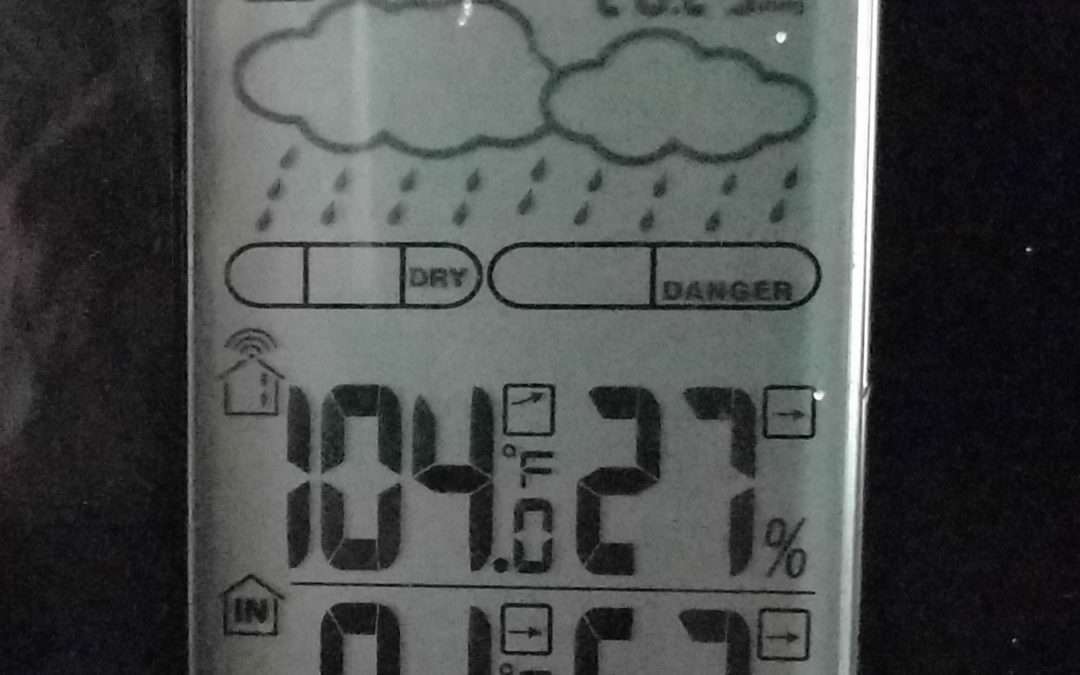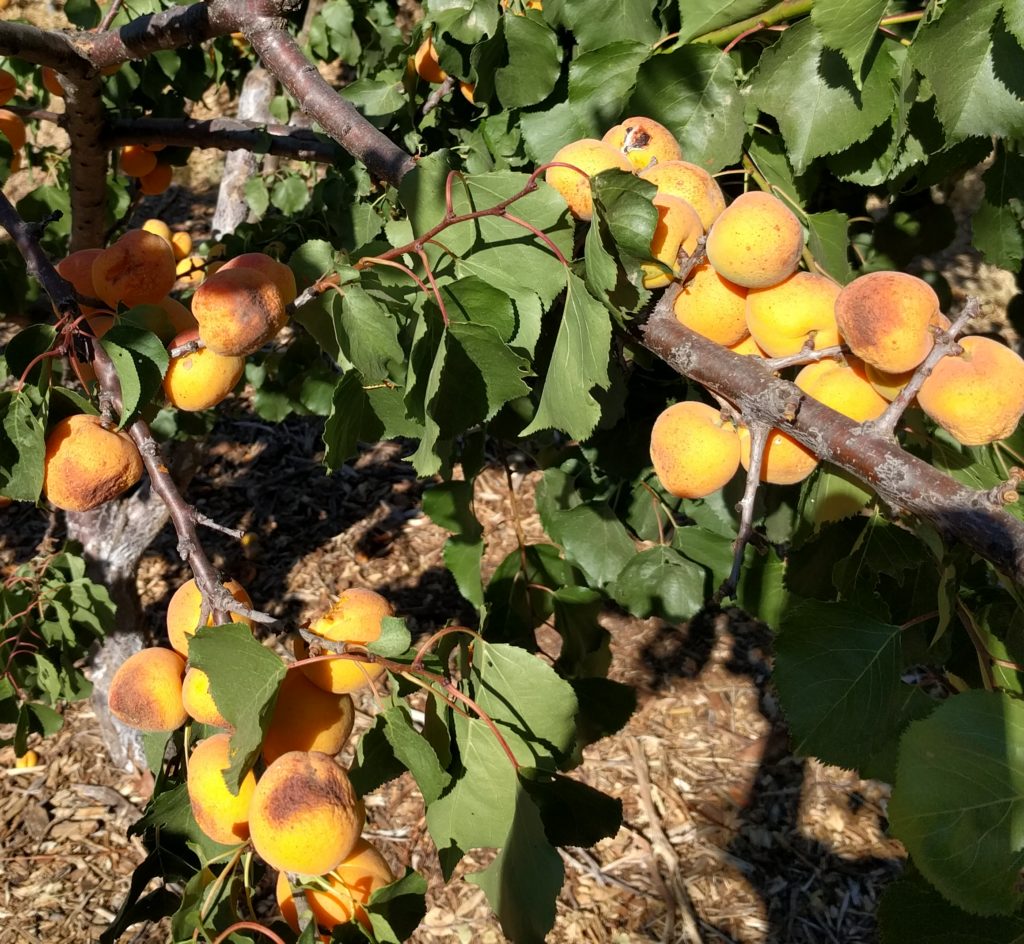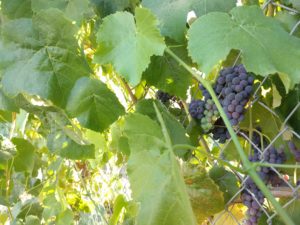Heat waves make me a worried gardener. What can I do to help my plants? Should I water again? How much?
This summer of 2017 has started off with a blast of multiple heat waves for Southern California’s valleys (the beach has been spared by the presence of a marine layer). In my yard, twenty miles from the ocean in San Diego County, it was over 95 for six days June 16 through 21, and then again for three days June 25 through 27. A couple days reached over 100.
But my vegetables and fruit trees came through pretty well, save some sunburned apricots:
I believe it’s because I’ve settled on a two-part watering routine that helps the plants cope with heat waves. Here’s what I do:
Pre-irrigate
First, I make a pre-emptive attack. I’m convinced that this is the most important thing to do. When a heat wave is predicted, I pre-irrigate, heavily. I learned this from Reuben Hofshi, an avocado farmer. The day before a heat wave is forecast to start, I water with enough to give all plants full moisture in the soil of their root zone, and then I add about 50% or more. So, for example, I gave my avocado and citrus trees a normal round of irrigation of three hours and 18 minutes, and then I applied an extra 50% of one hour and 39 minutes.
The idea is to make sure the trees have access to all the moisture their roots can touch. They’re totally prepared to pull up maximum amounts of water to supply their transpiring leaves in the stressful heat.
Replenish water daily
Second, I replenish the water used by some plants each day during the heat wave. I feel the need to do this for avocados and vegetables. I’ve noticed that they stress if I don’t. On the other hand, citrus and deciduous fruit trees (apricot, peach, pomegranate, plum, apple, etc.) don’t need such coddling. I don’t water them daily through a heat wave.
But for avocados and vegetables, I estimate how much water they’re using each day and replace it each day. For example, I gave my avocados 42 minutes each afternoon.
Meanwhile, for my vegetables, before the heat waves I had been watering my vegetables for 25 minutes every three days, which had been working well, and which is equal to about eight minutes per day. During the heat wave, I ran the drip lines on my vegetables for 12 minutes each day; that was my estimate of how much they needed. I came up with that time by taking the daily eight minutes and adding 50% (four minutes) since it was hotter than usual, which gave me 12 minutes.
To sum up, I pre-irrigate with at least 150% of what I think the plants need the day before the heat hits in order to be fully saturated, and then I irrigate every day during the heat with about 150% of what avocados and vegetables normally need each day in the summer.
Note:
Let me mention some factors about my specific situation and why they might make things work differently for you. My soil is sandy loam. If yours is clay, you shouldn’t need to water anything daily even in a heat wave. Also, I irrigate my vegetables with drip lines. When I used to irrigate with overhead sprinklers, I could get through heat waves without watering my vegetables daily. The sprinklers gave them larger root zones and therefore made for tougher plants.
I have always watered my deciduous fruit trees every ten days to two weeks in the summer. It is when a heat wave occurs that I’ll water every ten days; otherwise, during normal summer temperatures, it’s every two weeks. Deciduous fruit trees (and grapes) never stop surprising me by how little and infrequently they need water — while still producing oodles of great fruit. That’s why I keep planting more of them!
You might also like to read:






I wonder how different it will be watering in the sand hills of North Carolina? I also have no clue what grows well out here and what doesn’t. If you know anything that would be awesome
I probably know less than you, but I bet the Master Gardener association in your county has some reliable info: http://www.ncstategardening.org/extension_master_gardener. What county are you in again?
Moore County, I know peaches ???? grow well out here
I have a clay soil and always worried about root rot when watering my recently planted fruit trees. I planted a hedgerow of 16 fruit trees including a Hass avocado 2-3 months ago in my backyard. They were all 15Gal trees, plus a 24gal Meyer Lemon. During the 2-3 days of heat wave in July many of them got burned, lost leaves and fruits although I watered them every day. I made a high tunnel green house with 50% shade cloth for them before the heat wave but no luck!
Here what I have:
Wonderful Pomegranate (both did great during the heat wave)
5-in-1 Plum-Peach-Apricot
Fuyu Persimmon (little burn on top of the foliage but dropping fruits in past 2-3 days!)
Brown Turkey Fig (little burn on top of the foliage, fruits are OK)
Anna Apple (all the fruits and leaves dried up!)
3-in-1 Anna, Golden Dorsett, Fuji Apple tree (Doing well with minimum burn)
Persian Mulberry (little burn on top of the foliage)
Hass Avocado (Completely Burned, lost 90% of the foliage)
Donut Peach (doing OK)
Washington Orange (a little burn on the foliage)
4-in-1 Citrus (doing OK)
Meyer Lemon (almost OK, with minimal burn)
Loquat (half burned specially on the south)
Black Satan Blackberry (completely burn, in pot)
Blueberry (completely burn, in pot)
Hi PJ,
Thanks for the rundown. Sounds similar to trees I’ve seen, including in my own yard: worst damage has been to avocados and blackberries/raspberries and blueberries.
I have to add though that my oldest blueberry (about seven years old), had very few burned leaves compared to my younger ones. It’s the Sunshine Blue variety.
Can I ask if you watered heavily just before the heat also? Or only during the heat?
Hi Greg,
Unfortunately I did not water them heavily before the heat! I’m kinda new, but super passionate, on gardening, but lack of experience has probably made me too much worried!
As I mentioned I was worried about the root rot, so I never water them more than 3-4gal each time. My heavy clay soil keeps the moisture for a couple of days.
I read somewhere the solution is to give them less water like 2-3 gals each time but more frequently, like 2 times a week, 3 times during hot days.
I am thinking to use gypsum to break up the clay, but need to research a bit more as I’m not sure if great amount of gypsum affects the young trees. Usually the soil amendment process happen before planting trees, and my trees already planted.
I totally understand your fear. The best strategy to take with avocados in heavy soil is actually to water less often but with more volume each time compared to light (sandy) soil. For example, I have sandy loam soil and I water established trees (in ground for at least a year) about every five days in summer — more often during heat waves, of course. But you could and should water less often if your soil is heavy (unless you’re using drip irrigation, which requires high frequency).
If you add a layer of coarse wood chip mulch under your trees (at least five inches thick), you’ll find that within a couple months the upper inches of your soil are more friable without you having done any additional work. The earthworms and microbes and insects will do all of the work within and under that mulch for you.
Greg. It is August 4 2018 and there will be a heat wave of 108 plus starting in three days I have a 14 foot Hass avocado tree with almost 100 percent of the large leaves totally scorched how ever there is a massine new flush of small leaves mostly unprotected. I am deep watering once a day and misting the leaves 3 times a day to cool the tree down. I’m not sure if misting helps but it does cool the leaves down until the mist dries out. Does misting help and if so how about misting with a timer set for every minutes or so? Also can I drape sun shade over the tree however draping touches the outer young leaves which I heard is not good however the inner leaves would be protected. I Tried building a pvc cage around this large tree which was a complete failure. Also I would note the tree is in a windy corner of the orchard. One person down the road painted his whole young orchard leaves and all with white water based paint but I think his endeavors failed. I live in Riverside Ca.
Hi Robert,
Yes, misting does help, and doing it on a timer is ideal. I talked about that a bit in my reply to your comment on this post: Caring for your garden during a heat wave.
Good question about the shade touching the leaves. I’m not sure if that would do more protection than damage to your tree in particular. But I have had shade touching just a few leaves on a couple avocado trees before, burning them a little, but protecting all the other leaves — and I found that worthwhile. If it’s windy though, it may turn into a real mess if the shade is heavy and it breaks off twigs, etc.
It sounds like your best bet might be just misting on a timer. I’ve read studies that say consistent misting can drop the temperature 10-20 degrees. (Misting is how they cool greenhouses.) That’s significant. I’ve only noticed damage to avocado foliage when the temperature is over 103, provided the leaves are acclimated to heat, and yours should be.
Great information! I am in sata clarita with a struggling bacon avocado tree. 3′ tall and been in the ground for about 3 months. I didnt want to over water in the beginning but the heat is really getting to this guy. I have him on 2 sprinkler lines that wster for 3 minutes 2x a day. I have been doing an additional heavy soak midday on the hottest days. I do epsom water 1x a week and have iv organics paint on the trunk…i am new. I should add that the tree is fairly close to a cinderblock wall which i am sure adds some heat. Any advice would be greatly appreciated!
Hi Kelly,
Since our temperatures are almost back to normal for the moment (August 20), and your tree has been in the ground for three months, you should be watering less often but with more volume each time.
The Santa Clarita climate is only a tad hotter and drier than mine, so you can water similarly to me. I planted two trees in late April and they now get water every three to four days. For a three-foot tall tree, you should give it the equivalent of a gallon a day, which would mean 3-4 gallons every three to four days (so you’re applying about seven gallons per week). This is if the tree has a lot of leaves; if the leaves are sparse, you can give it fewer gallons but keep the same frequency.
The trouble with sprinkling a couple times a day with only a little water each time is that the water doesn’t penetrate very deep and much of it is evaporated by the sun. You can see if this is true by digging a little hole and checking how deep the soil is moist.
For watering recommendations going into the fall and winter see my post, “How much and how often to water avocado trees in California.”
Of great help to your little tree would also be a layer of mulch underneath — if you haven’t already. Lay down leaves, tree trimmings, compost, or anything similar. Avocado trees loooooove mulch!
I have an avocado tree that was here when we moved in 7 years ago. Last year it gave lots of fruit. However, since the hot spell on July 7-8, the leaves on the top half of the tree are brown. During July, fruit had started growing but now (Sept 3) the avocados grew to about 3-4″ and have not grown any bigger these past 2 months. The fruit does not have black spots. There were some very small ones that turned black and fell off the tree. None have fallen for a couple of weeks now. We have dug sort of a shallow trench around the tree and watered it every other day. Will this fruit ever mature further (get bigger) so they are edible?